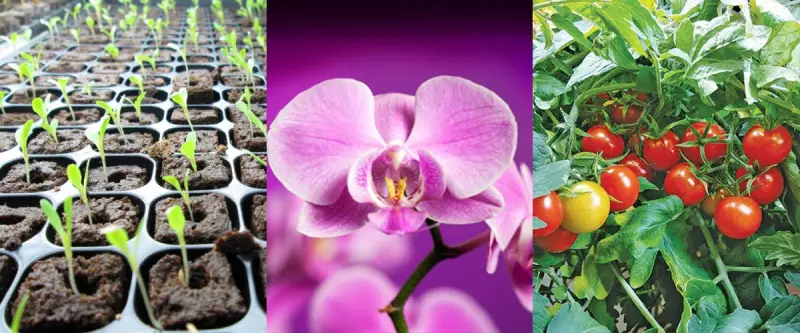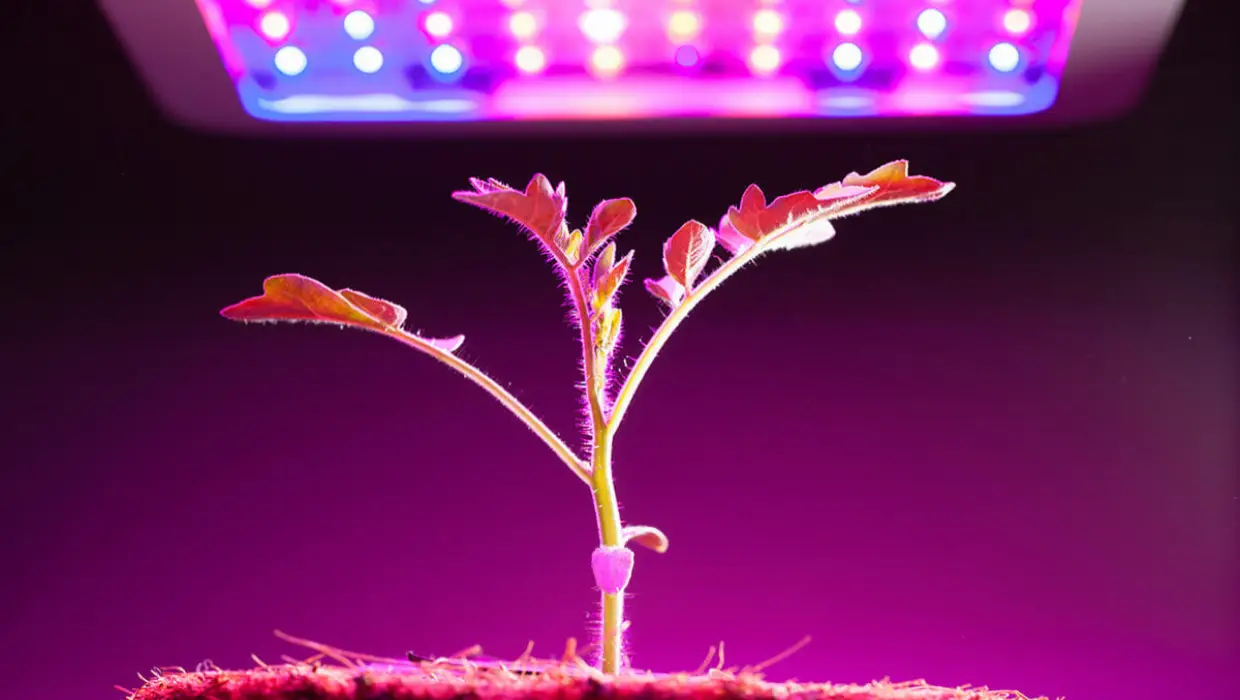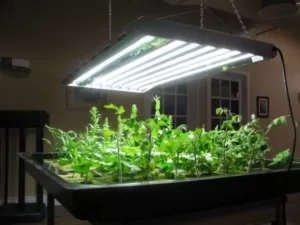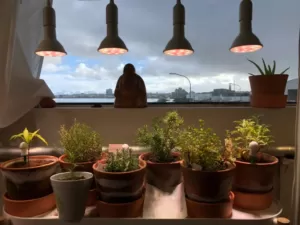Don’t worry if you’re new to the world of plant grow lights and feeling overwhelmed. This post will walk you through the process of selecting the plant grow light that best suits your requirements. You can save time and money while assuring the highest crop quality by following these tips.
What to Consider When Buying Plant Grow Lights?
Type of Plant Grow Lights
While LED lights have become the mainstream choice for plant growth, other types of grow lights still have their place in specific environments.
Incandescent Lights
Incandescent lights are relatively cheap but not efficient for plant growth. They convert a large amount of energy into heat, which is wasted as plants cannot absorb it. Daher, in the long run, the cost of using incandescent lights becomes higher compared with other types of grow lights. Their light output is also limited, making them suitable only for small-scale plant cultivation. For larger gardens or plantations, other types of grow lights will be more suitable.
Fluorescent Lights
Fluoreszierende Wachstumslichter have low light output, which limits their effectiveness in promoting plant growth. They can be useful for plants in the early stages, such as seeds or seedlings, but once plants develop larger leaves that require more energy, the light produced by fluorescent lamps may not effectively support photosynthesis. Jedoch, for plants with low photosynthetic demands, fluorescent lights can be a reasonable choice.
VERSTECKT (High-Intensity Discharge) Beleuchtung
Der HID-Leuchten have high light efficiency and provide intense light when turned on, but they are relatively expensive. The commonly used HID bulb types include mercury vapor lamps, low-pressure sodium lamps, Metallhalogenidlampen, und Natriumdampf-Hochdrucklampen. High-pressure sodium lamps and metal halide lamps are more popular due to their cost-effectiveness and efficiency. Using 260-watt HID lights per square meter can promote rapid plant growth. HID lights are available in various wattages, wie zum Beispiel 1000 watts suitable for 4.5 Quadratmeter, Und 400 watts suitable for 1.4 square meters of indoor plant cultivation.
- High-pressure sodium lamps produce a reddish-orange light that promotes flowering in plants. They have a longer lifespan compared with metal halide lamps. high-pressure sodium lamps alone may cause plants to grow slender and have growth deficiencies due to their lack of blue light. Somit, when using high-pressure sodium lamps as the primary light source for crop growth, it is beneficial to supplement them with other types of grow lights to provide a more comprehensive spectrum of light.
- Metal halide lamps emit a blue-white light that promotes the growth of green leaves. They provide a broader spectrum of light necessary for plant growth. Jedoch, after approximately 10,000 hours of use, the light quality of metal halide lamps diminishes, so it is recommended to replace them at this point to maintain optimal results.
LED Lights

LED lighting technology has garnered significant attention and investment from companies and research institutions in recent years, as it is considered the ideal lighting technology for the future. They are highly suitable for plant growth due to their customizable nature. They can be adjusted to produce full-spectrum or single-spectrum light based on the specific needs of plants. This flexibility in the light spectrum enhances photosynthesis, improves light utilization, and can even manipulate flowering and fruiting processes to achieve desired growth outcomes.
In comparison to other light sources, LED lights are more energy-effective and eco-friendly. They generate less heat while providing intense light intensity. The reduced heat production allows the lights to be put closer to crops without the danger of burning them, ensuring better light absorption and further improving efficiency.
Zusätzlich, the lifespan of LED lights is much longer than HID lamps. An average MOKOLight LED-Wachstumslicht has a lifespan of 50,000 Std., whereas a high-pressure sodium lamp in HID lighting typically lasts only 3,000 Std..
Although HID lamps have a lower upfront cost, they emit less light and generate more heat. daher, when plants absorb the same amount of light, HID lamps consume more power. When considering overall costs, the expense of LED lights is significantly lower than HID lights. Außerdem, LED lights are compact, stable, and adaptable to various lighting requirements.
When purchasing grow lights, it is essential to consider factors beyond the selling price. Parameters such as lifespan, Spektrum, and power consumption should be evaluated, along with usage costs and depreciation rates.
Your Crop Needs
Having a clear plan for the crops you intend to grow in advance simplifies decision-making when it comes to selecting appropriate lighting. Understanding the crop types and quantities will help determine the required intensity, Spektrum, coverage, and bulb type for your plants. Knowing the crop type is crucial as it directly influences the lighting needs. Zum Beispiel, if you focus on cultivating microgreens, your lighting requirements will differ significantly from growing flowers. This distinction arises from the fact that plants have varying lighting needs at different stages of growth.
Budget
Having a predetermined budget in mind before embarking on your shopping journey can simplify the process by allowing you to eliminate certain options from the outset. When planning your budget, take into account your desired energy expenses and the amount of light required. The wattage of the chosen bulbs directly impacts your energy expenses. If you have a small-scale operation with only a few plants, energy costs may not be a significant concern. Jedoch, for commercial-scale farmers, opting for high-efficiency lights becomes crucial since these lights will be in use for at least 12 Stunden täglich, resulting in substantial energy consumption.
Licht Spektrum
Light is available in various colors, known as the Spektrum. Plants primarily utilize rotes und blaues Licht, as well as a tiny quantity of yellow and grünes Licht. Blue light is crucial during vegetative stages to promote leaf and root development, while red light plays a significant role in flower and fruit production.
There are two types of grow lights: targeted spectrum and Das ganze Spektrum. Targeted spectrum lights produce a specific color, such as red or blue light, making them suitable for specific growth stages of plants. Andererseits, full-spectrum bulbs mimic natural sunlight and cover all stages of plant growth. Zusätzlich, full-spectrum bulbs emit white light, which is easier for humans to perceive.
Some targeted spectrum lights are equipped with a color-switching feature, allowing them to be used for different growth stages. In the case of growing microgreens, full-spectrum light is unnecessary as these plants require more blue light for optimal growth.
Licht Intensity
It is a crucial factor because you need to ensure that the light can emit the appropriate amount of light for your plants at every growth stage. The higher the intensity of a grow light, the greater the distance it can be placed from the plants to lessen the risk of heat, which trigger burns. To determine if the intensity is suitable for your desired coverage area, it is advisable to consult the manufacturer’s recommendations.
Manufacturers typically provide an estimated coverage area for their grow lights. Jedoch, if you aim for optimal results, you should take additional steps. Look at the photosynthetic photon flux density (PPFD). This measurement represents the average density of the total light output and indicates the intensity of the light in a specific area.
Light intensity is highest at the center point and gradually diminishes as you move away from that point. To assess the distribution of light intensity, refer to the photosynthetic active radiation (PAR) chart provided by the manufacturer. The PAR chart illustrates the distribution of the light’s PPFD across an area. The intensity will be highest in the middle, lower at the edges, and lowest in the corners. Ideally, you should aim for a grow light with a relatively low PPFD and an even distribution, as indicated in the PAR chart.
Coverage
After narrowing down your list of potential grow lights, you should determine how many lights you will need to purchase based on your grow space. Measure your grow space to determine its area in square feet. 20 Zu 40 watts of coverage per square foot are often advised. Take the wattage of one of the potential grow lights and divide it by 20 to find the lowest area in square feet that the bulb will cover. Divide the wattage by 40 to find the highest area it can cover. Zum Beispiel, if you have a 2,000-watt bulb, it can light between 50 Und 100 square feet of your grow space.
Zusätzlich, for more accurate coverage, match the results from the PAR chart (indicating light intensity distribution) with your grow space. Suppose the PAR chart shows fairly uniform density until it reaches a 16-square-foot area. To light a 96-square-foot grow space with that bulb, du bräuchtest 6 of them. Unless you are only growing a few plants, it is recommended to purchase multiple lights rather than one large light to ensure full coverage and even intensity distribution.
Height and Mobility
Before purchasing grow lights, it’s vital to consider the distance between the lights and your plants, as well as the level of adjustability and mobility you desire. Many grow lights offer adjustable features that allow you to maintain a consistent distance between the light and your plants as they grow. Zum Beispiel, the light can be positioned closer to the plants during the sprouting stage and then raised higher as the plants mature. When selecting a grow light, ensure that it either comes with this adjustable function This is particularly important if you are growing taller crops that require more vertical space.
It’s crucial to keep the heat generated by the bulb in mind. As the bulb gets hotter, you’ll want to maintain a greater distance between the light and your plants to avoid any heat-related damage. If adjusting the distance interferes with the desired intensity and wattage levels, you may need to explore alternative grow lights that can better meet your requirements.
Recommendations for Purchasers of Household Plant Grow Lights
When it comes to household or amateur growers who require supplementary lighting, the primary consideration is light efficiency. Since they typically use a single grow lamp instead of a larger setup, it is important to choose a grow light that maximizes the light output while minimizing energy consumption and optimizing irradiation.
For home buyers, the following factors should be taken into account:
High Lklar Effizienz
Opt for a grow light that has high light efficiency. This means that it produces more light and less heat for the same power. This type of lighting effect not only enhances plant growth but also saves energy.
Uniform Lighting
Ensure that the grow light provides uniform lighting. When the light emitted is evenly distributed, it promotes consistent and healthier plant growth, preventing any irregular or abnormal growth patterns.
Reasonable Spectrum Ratio
Consider the specific light spectrum requirements of your plants. Different plants respond differently to light spectrums, with some favoring red light, others benefiting from blue light, and some requiring a combination of both. An appropriate spectrum ratio is crucial to avoid wasting energy and potentially hindering plant growth. If you are uncertain about the ideal spectrum ratio, it is advisable to choose a full-spectrum grow light.
Recommendations for Professional Growers
As a professional grower, it is crucial to exercise caution when selecting LED grow lights. Choosing the right grow lights is essential for achieving optimal crop growth, as a poor choice can have a negative impact and even inhibit plant development. To ensure success, the following key points should be considered:
Select Plant Grow Lights with a Suitable Spectrum
Different crops have varying light requirements based on their growth conditions. Collect data regarding the light needs of your specific plants and choose the grow light accordingly. This will help maximize the emitted light energy and cater to the specific needs of your crops.
Plan the Arrangement of Plant Grow Lights Thoughtfully
Consider factors such as plantation area, grow light types, power, irradiation area, and heat generation. Arrange the grow lights in a manner that optimizes their effectiveness. This involves finding the right density of grow lights and determining the appropriate distance between the lights and the crops. A well-designed layout ensures that plants receive sufficient light while minimizing the number of grow lights required, thus reducing the cost of purchasing lights and energy consumption.
Estimate the Cost of Supplementary Lighting
The decision to invest in grow lights is driven by the goal of achieving better profitability. It is essential to evaluate the cost-effectiveness of installing grow lights. Consider factors such as the lifespan, Lichtausbeute, Energieverbrauch, and price of the grow lights. Assess the overall purchase cost and operational expenses, taking into account the expected crop yield. This comprehensive evaluation will help make an informed purchasing decision.
By carefully considering these factors, professional growers can choose the most suitable LED grow lights that meet the specific light requirements of their crops, optimize growth conditions, and ensure cost-effective implementation.
LED Plant Grow Lights Portfolio at Mokolight

Mokolight places a significant emphasis on plant grow lights due to their ability to promote healthy plant growth, even in challenging weather or dark winters. We ensure that our LEDs are designed with adjustable spectrum, Intensität, and height. Außerdem, our LED lights have gained ROHS, UL, and IPC certifications. Für weitere Informationen oder Unterstützung, please kontaktiere uns.










